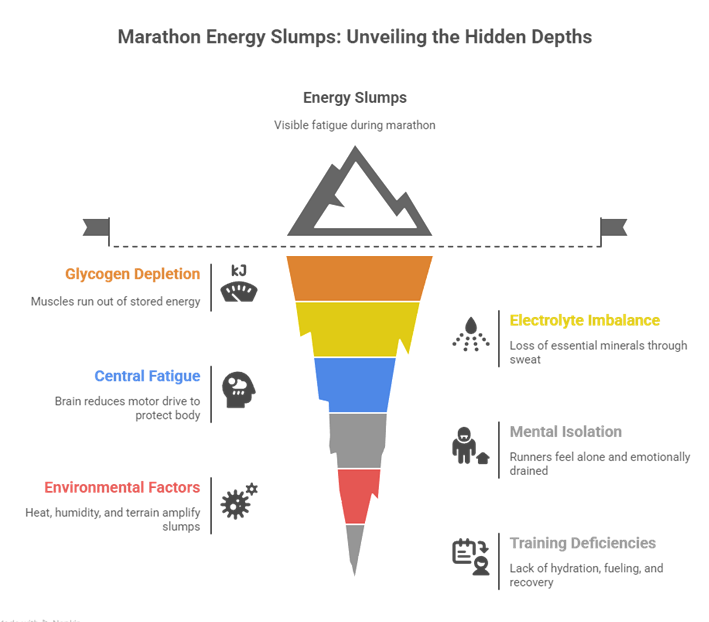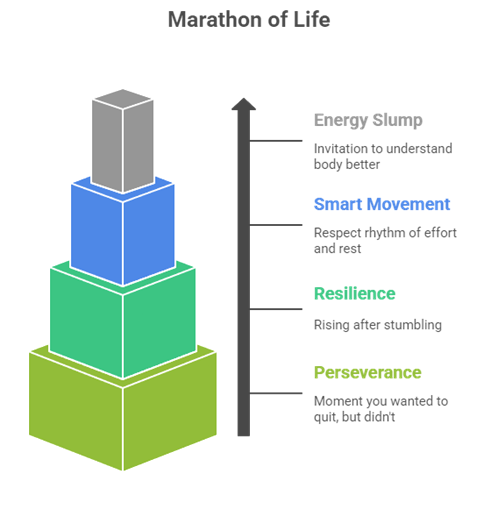It doesn’t always happen at 30 kilometers. Sometimes it strikes at 18. Sometimes at 12. A creeping heaviness in your legs, your heartbeat louder than the cheering crowd, and a voice in your head that whispers — stop.
Energy slumps in marathons are real, brutal, and deeply misunderstood.
They’re not a sign of weakness. They’re the body’s emergency alarm — triggered when fuel runs low, hydration drops, or the mind begins to question the mission.
In India, where running culture is booming — from Bengaluru’s techies to Chennai’s homemakers, from army cadets to barefoot village champions — more and more runners are learning that finishing a marathon is not about ego. It’s about energy intelligence.
What Causes the “Wall” in Long-Distance Running?
Marathoners often talk about “hitting the wall.” Scientifically, that wall has a name: glycogen depletion.
Here’s what’s happening:
1. Glycogen Burnout
Your muscles rely on stored carbohydrates (glycogen) for energy. After 90–120 minutes of running, that supply runs low — causing fatigue, disorientation, and heavy legs.
2. Electrolyte Imbalance
You sweat out sodium, potassium, and magnesium. Without replacement, your muscles start to cramp and coordination drop.
3. Central Fatigue
It’s not just physical. The brain, sensing risk, reduces motor drive to protect the body — making you feel unmotivated, foggy, or even panicked.
4. Mental Isolation
Even in a crowd, many runners feel mentally “alone” after the halfway mark — and emotional dips can feel just as heavy as physical fatigue.
Why This Matters for Indian Runners
In India, marathons often happen in heat, humidity, or uneven terrain — which amplifies energy slumps:
- Lack of hydration stations in smaller cities
- Few coaches focusing on scientific fuelling
- Late-night training due to work-life imbalance
- Underrated recovery rituals after races
For the growing community of Indian runners — from Tirunelveli to Thane — learning how to prepare for, recognize, and push through energy slumps is the key to going from painful finish to powerful performance.
Seven Science-Backed Ways to Outsmart the Slump
1. Carb-Load the Smart Way
Two to three days before race day, increase complex carbohydrates like oats, rice, or ragi to fill glycogen store.
2. Hydrate with Electrolytes, Not Just Water
Use ORS or electrolyte tablets during training, especially in Indian summer races.
3. Fuel During the Race
After 60 minutes, take glucose gels, dates, or sports drinks at regular intervals. Train your gut to handle mid-run snacks.
4. Mind the Pace
Starting fast leads to early depletion. Maintain a sustainable rhythm until the final quarter.
5. Mental Anchors Matter
Create checkpoints in your mind — at 25 kilometers, check in with your breath; at 30 kilometers, take your energy gel.
6. Body Scan Technique
Every 15–20 minutes, do a head-to-toe mental scan: posture, breath, jaw tension, stride — reset and recalibrate.
7. Practice Slump Recovery in Training
Intentionally train under mild heat or on tired legs (under supervision) to simulate and master real-race slumps.

Beyond Finish Lines: What Slumps Teach Us
An energy slump isn’t a failure — it’s an invitation.
To know your body better. To move smarter. To respect the rhythm of effort and rest.
In many ways, running a marathon mirrors how we live. We push, we stretch, we stumble, and then — we rise again. And just like in life, the most important part of the race isn’t the start or the medal — it’s the moment you wanted to quit, but didn’t.

Final Word
Running on empty happens to everyone.
But those who finish strong aren’t the ones who never hit the wall — they’re the ones who learned to break through it.
Marathon running is not about power.
It’s about patience, pacing, and precision.

